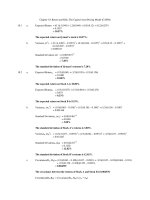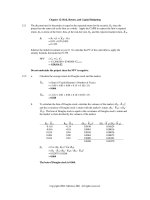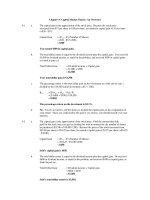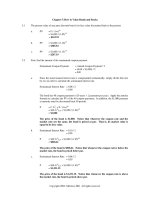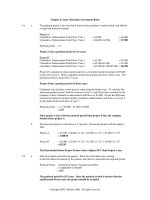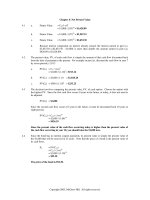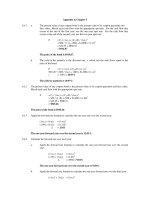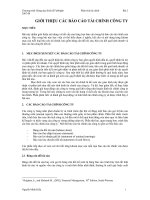Tài liệu Tài chính doanh nghiệp ( Bài tập)_ Chapter 7 doc
Bạn đang xem bản rút gọn của tài liệu. Xem và tải ngay bản đầy đủ của tài liệu tại đây (352.02 KB, 38 trang )
Chapter 7: Net Present Value and Capital Budgeting
7.1 a. Yes, the reduction in the sales of the company’s other products, referred to as erosion, should be
treated as an incremental cash flow. These lost sales are included because they are a cost (a
revenue reduction) that the firm must bear if it chooses to produce the new product.
b. Yes, expenditures on plant and equipment should be treated as incremental cash flows. These are
costs of the new product line. However, if these expenditures have already occurred, they are
sunk costs and are not included as incremental cash flows.
c. No, the research and development costs should not be treated as incremental cash flows. The
costs of research and development undertaken on the product during the past 3 years are sunk
costs and should not be included in the evaluation of the project. Decisions made and costs
incurred in the past cannot be changed. They should not affect the decision to accept or reject the
project.
d. Yes, the annual depreciation expense should be treated as an incremental cash flow. Depreciation
expense must be taken into account when calculating the cash flows related to a given project.
While depreciation is not a cash expense that directly affects cash flow, it decreases a firm’s net
income and hence, lowers its tax bill for the year. Because of this depreciation tax shield, the
firm has more cash on hand at the end of the year than it would have had without expensing
depreciation.
e. No, dividend payments should not be treated as incremental cash flows. A firm’s decision to pay
or not pay dividends is independent of the decision to accept or reject any given investment
project. For this reason, it is not an incremental cash flow to a given project. Dividend policy is
discussed in more detail in later chapters.
f. Yes, the resale value of plant and equipment at the end of a project’s life should be treated as an
incremental cash flow. The price at which the firm sells the equipment is a cash inflow, and any
difference between the book value of the equipment and its sale price will create gains or losses
that result in either a tax credit or liability.
g. Yes, salary and medical costs for production employees hired for a project should be treated as
incremental cash flows. The salaries of all personnel connected to the project must be included as
costs of that project.
7.2 Item I is a relevant cost because the opportunity to sell the land is lost if the new golf club is produced.
Item II is also relevant because the firm must take into account the erosion of sales of existing products
when a new product is introduced. If the firm produces the new club, the earnings from the existing clubs
will decrease, effectively creating a cost that must be included in the decision. Item III is not relevant
because the costs of Research and Development are sunk costs. Decisions made in the past cannot be
changed. They are not relevant to the production of the new clubs. Choice C is the correct answer.
7.3 Cash Flow Chart:
Year 0 Year 1 Year 2 Year 3 Year 4
1. Sales revenue - $7,000 $7,000 $7,000 $7,000
2. Operating costs - 2,000 2,000 2,000 2,000
3. Depreciation - 2,500 2,500 2,500 2,500
4. Income before tax
[1-(2+3)]
- 2,500 2,500 2,500 2,500
5. Taxes at 34% - 850 850 850 850
6. Net income
[4-5]
0 1,650 1,650 1,650 1,650
7. Cash flow from
operation
[1-2-5]
0 4,150 4,150 4,150 4,150
8. Initial Investment -$10,000 - - - -
9. Changes in net working
capital
-200 -50 -50 100 200
10. Total cash flow from
investment
[9+10]
-10,200 -50 -50 100 200
11. Total cash flow
[7+10]
-$10,200 $4,100 $4,100 $4,250 $4,350
a. Incremental Net Income [from 6]:
Year 0
0
Year 1
$1,650
Year 2
$1,650
Year 3
$1,650
Year 4
$1,650
b. Incremental cash flow [from 11]:
Year 0
-$10,200
Year 1
$4,100
Year 2
$4,100
Year 3
$4,250
Year 4
$4,350
c. The present value of each cash flow is simply the amount of that cash flow discounted back from the
date of payment to the present. For example, discount the cash flow in Year 1 by 1 period (1.12), and
discount the cash flow that occurs in Year 2 by 2 periods (1.12)
2
. Note that since the Year 0 cash flow
occurs today, its present value does not need to be adjusted.
PV(C
0
) = -$10,200
PV(C
1
) = $4,100 / (1.12) = $3,661
PV(C
2
) = $4,100 / (1.12)
2
= $3,268
PV(C
3
) = $4,250 / (1.12)
3
= $3,025
PV(C
4
) = $4,350 / (1.12)
4
= $2,765
NPV = PV(C
0
) + PV(C
1
) + PV(C
2
) + PV(C
3
) + PV(C
4
) = $2,519
These calculations could also have been performed in a single step:
NPV = -$10,200 + $4,100 / (1.12) + $4,100 / (1.12)
2
+ $4,250 / (1.12)
3
+ $4,350 / (1.12)
4
= $2,519
The NPV of the project is $2,519.
7.4 The initial payment, which occurs today (year 0), does not need to be discounted:
PV = $1,400,000
The expected value of his bonus payment is:
Expected Value = C
0
(Probability of Occurrence) + C
1
(Probability of Nonoccurrence)
= $750,000 (0.60) + $0 (0.40)
= $450,000
The expected value of his salary, including the expected bonus payment, is $2,950,000 (=$2,500,000 +
$450,000).
The present value of his three-year salary with bonuses is:
PV Annuity = C
1
A
T
r
= $2,950,000 A
3
0.1236
= $7,041,799
Remember that the annuity formula yields the present value of a stream of cash flows one period prior to
the initial payment. Therefore, applying the annuity formula to a stream of cash flows that begins four
years from today will generate the present value of that annuity as of the end of year three. Discount that
result by three years to find the present value.
PV Delayed Annuity = (A
T
r
) / (1+r)
T-1
= ($1,250,000 A
10
0.1236
) / (1.1236)
3
= $4,906,457
Thus, the total PV of his three-year contract is:
PV = $1,400,000 + $2,950,000 A
3
0.1236
+ ($1,250,000 A
10
0.1236
) / (1.1236)
3
= $1,400,000 + $7,041,799 + $4,906,457
= $13,348,256
The present value of the contract is $13,348,256.
7.5 Compute the NPV of both alternatives. If either of the projects has a positive NPV, that project is more
favorable to Benson than simply continuing to rent the building. If both of the projects have positive net
present values, recommend the one with the higher NPV. If neither of the projects has a positive NPV, the
correct recommendation is to reject both projects and continue renting the building to the current
occupants.
Note that the remaining fraction of the value of the building and depreciation are not incremental and
should not be included in the analysis of the two alternatives. The $225,000 purchase price of the building
is a sunk cost and should be ignored.
Product A: t = 0 t = 1 - 14 t = 15
Revenues $105,000 $105,000
-Foregone rent 12,000 12,000
-Expenditures 60,000 63,750 **
-Depreciation* 12,000 12,000
Earnings before taxes $21,000 $17,250
-Taxes (34%) 7,140 5,865
Net income $13,860 $11,385
+Depreciation 12,000 12,000
Capital investment -$180,000
A/T-NCF -$180,000 $25,860 $23,385
*Since the two assets, equipment and building modifications, are depreciated on a straight-line basis, the
depreciation expense will be the same in each year. To compute the annual depreciation expense,
determine the total initial cost of the two assets ($144,000 + $36,000 = $180,000) and divide this amount
by 15, the economic life of each of the 2 assets. Annual depreciation expense for building modifications
and equipment equals $12,000 (= $180,000 / 15).
**Cash expenditures ($60,000) + Restoration costs ($3,750)
The cash flows in years 1 - 14 (C
1
- C
14
) could have been computed using the following simplification:
After-Tax NCF = Revenue (1 – T
C
) - Expenses (1 - T
C
) + Depreciation (T
C
)
= $105,000 (0.66) - $72,000 (0.66) + $12,000 (0.34)
= $25,860
The cash flows for year 15 could have been computed by adjusting the annual after-tax net cash flows of
the project (computed above) for the after-tax value of the restoration costs.
After-Tax value of restoration costs = Restoration Costs (1 - T
C
)
= -$3,750 (0.66)
= -$2,475
After-Tax NCF = $25,860 - $2,475
= $23,385
The present value of the initial outlay is simply the cost of the outlay since it occurs today (year 0).
PV(C
0
) = -$180,000
Since the cash flows in years 1-14 are identical, their present value can be found by determining
the value of a 14-year annuity with payments of $25,860, discounted at 12 percent.
PV(C
1-14
) = $25,860 A
14
0.12
= $171,404
Because the last cash flow occurs 15 years from today, discount the amount of the
cash flow back 15 years at 12 percent to determine its present value.
PV(C
15
) = $23,385 / (1.12)
15
= $4,272
NPV
A
= PV(C
0
) + PV(C
1-14
) + PV(C
15
)
= -$4,324
These calculations could also have been performed in a single step:
NPV
A
= -$180,000 + $25,860 A
14
0.12
+ $23,385 / (1.12)
15
= -$180,000 + $171,404 + $4,272
= -$4,324
Since the net present value of Project A is negative, Benson would rather rent the building to its
current occupants than implement Project A.
Product B t = 0 t = 1 - 14 t = 15
Revenues $127,500 $127,500
-Foregone rent 12,000 12,000
-Expenditures 75,000 103,125 **
-Depreciation* 14,400 14,400
Earnings before taxes $26,100 -$2,025
-Taxes (34%) 8,874 -689
Net income $17,226 -$1,336
+Depreciation 14,400 14,400
Capital investment -$216,000
A/T-NCF -$216,000 $31,626 $13,064
* Since the two assets, equipment and building modifications, are depreciated on a straight-line basis, the
depreciation expense will be the same in each year. To compute the annual depreciation expense, determine
the total initial cost of the two assets ($162,000 + $54,000 = $216,000) and divide this amount by 15, the
economic life of each of the two assets. Annual depreciation expense for building modifications and
equipment is $14,400 (= $216,000/ 15).
**Cash expenditures ($75,000) + Restoration costs ($28,125)
The cash flows in years 1 - 14 (C
1
- C
14
) could have been computed using the following simplification:
After-Tax NCF = Revenue (1 - T) - Expenses (1 - T) + Depreciation (T)
= $127,500 (0.66) - $87,000 (0.66) + $14,400 (0.34)
= $31,626
The cash flows for year 15 could have been computed by adjusting the annual after-tax net cash flows of
the project (computed above) for the after-tax value of the restoration costs.
After-tax value of restoration costs = Restoration Costs (1 - T
C
)
= - $28,125(0.66)
= -$18,562
After-Tax NCF = $31,626 - $18,562
= $13,064
The present value of the initial outlay is simply the cost of the outlay since it occurs today (year 0).
PV(C
0
) = -$216,000
Because the cash flows in years 1-14 are identical, their present value can be found by determining
the value of a 14-year annuity with payments of $31,626, discounted at 12 percent.
PV(C
1-14
) = $31,626 A
14
0.12
= $209,622
Since the last cash flow occurs 15 years from today, discount the amount of the
cash flow back 15 years at 12 percent to determine its present value.
PV(C
15
) = $13,064 / (1.12)
15
= $2,387
NPV
B
= PV(C
B
0
) + PV(C
1-14
) + PV(C
15
)
= -$216,000 + $209,622 + $2,387
= -$3,991
These calculations could also have been performed in a single step:
NPV
B
= -$216,000 + $31,626 A
B
14
0.12
+ $13,064 / (1.12)
15
= -$216,000 + $209,622 + $2,387
= -$3,991
Since the net present value of Project B is negative, Benson would rather rent the building to its
current occupants than implement Project B.
Since the net present values of both Project A and Project B are negative, Benson should continue to
rent the building to its current occupants.
7.6
Year 0 Year 1 Year 2 Year 3 Year 4 Year 5
1. Keyboards Produced
2. Price per Keyboard
3. Sales revenue [1*2]
4. Cost per Keyboard
10,000
40
400,000
20
10,000
40(1.05)
420,000
20(1.10)
10,000
40(1.05)
2
441,000
20(1.10)
2
10,000
40(1.05)
3
463,050
20(1.10)
3
10,000
40(1.05)
4
486,203
20(1.10)
4
5. Operating costs[1*4] 200,000 220,000 242,000 266,200 292,820
6. Gross Margin [3-5]
7. Depreciation
200,000
80,000
200,000
80,000
199,000
80,000
196,850
80,000
193,383
80,000
8. Pretax Income [6-7] 120,000 120,000 119,000 116,850 113,383
9. Taxes at 34% 40,800 40,800 40,460 39,729 38,549
10. Net income [8-9] 79,200 79,200 78,540 77,121 74,834
11. Cash flow from
operations [10+7]
159,200 159,200 158,540 157,121 154,834
12. Investment
13. Total Cash Flow
-400,000
-$400,000 $159,200 $159,200 $158,540
$157,121 $154,834
Since the initial investment occurs today (year 0), its present value does not need to be adjusted.
PV(C
0
) = -$400,000
PV(C
1
) = $159,200 / (1.15) = $138,435
PV(C
2
) = $159,200 / (1.15)
2
= $120,378
PV(C
3
) = $158,540 / (1.15)
3
= $104,243
PV(C
4
) = $157,121 / (1.15)
4
= $89,834
PV(C
5
) = $154,834 / (1.15)
5
= $76,980
NPV = PV(C
0
) + PV(C
1
) + PV(C
2
) + PV(C
3
) + PV(C
4
) + PV(C
5
) = $129,870
These calculations could also have been performed in a single step:
NPV = -$400,000+ $159,200 / (1.15) + $159,200 / (1.15)
2
+ $158,540 / (1.15)
3
+ $157,121 / (1.15)
4
+ $154,834 / (1.15)
5
= $129,870
The NPV of the investment is $129,870.
7.7
Year 0 Year 1 Year 2 Year 3 Year 4 Year 5
1. Annual Salary Savings $120,000 $120,000 $120,000 $120,000 $120,000
2. Depreciation 100,000 100,000 100,000 100,000 100,000
3. Taxable Income [1- 2] 20,000 20,000 20,000 20,000 20,000
4. Taxes 6,800 6,800 6,800 6,800 6,800
5. Operating Cash Flow [1-
4]
113,200 113,200 113,200 113,200 113,200
6.
Δ Net working capital
$100,000 -100,000
7. Investment -$500,000 66,000*
8. Total Cash Flow -$400,000 $113,200 $113,200 $113,200 $113,200 $79,200
* When calculating the salvage value, remember that tax liabilities or credits are generated on the
difference between the resale value and the book value of the asset. In this case, the computer has a book
value of $0 and a resale value of $100,000 at the end of year 5. The total amount received in salvage value
is the resale value minus the taxes paid on the difference between the resale value and the book value:
$66,000 = $100,000 - 0.34 ($100,000 - $0).
PV(C
0
) = -$400,000
PV(C
1
) = $113,200 / (1.12) = $101,071
PV(C
2
) = $113,200 / (1.12)
2
= $90,242
PV(C
3
) = $113,200 / (1.12)
3
= $80,574
PV(C
4
) = $113,200 / (1.12)
4
= $71,941
PV(C
5
) = $79,200 / (1.12)
5
= $44,940
NPV = PV(C
0
) + PV(C
1
) + PV(C
2
) + PV(C
3
) + PV(C
4
) + PV(C
5
) = -$11,232
These calculations could also have been performed in a single step:
NPV = -$400,000 + $113,200 / (1.12) + $113,200 / (1.12)
2
+ $113,200 / (1.12)
3
+
$113,200 / (1.12)
4
+ $79,200 / (1.12)
5
= -$11,232
Since the NPV of the computer is negative, it is not a worthwhile investment.
7.8
t = 0 t = 1- 2 t = 3
1. Revenues $600,000 $600,000
2. Expenses 150,000 150,000
3. Depreciation 150,000 150,000
4. Pretax Income
[1-2-3]
$300,000 $300,000
5. Taxes (35%) 105,000 105,000
6. Net Income [4-5] $195,000 $195,000
7. Net Working Capital - 25,000 $25,000
8. CF from Operations
[6+3+7]
9. Capital Investment
- 25,000
- $750,000
$345,000 $370,000
$40,000
10. Tax benefit from
Capital Loss*
$91,000
11. A/T-NCF
- $775,000 $345,000 $501,000
* The capital loss arises because the resale value ($40,000) is less than the net book value ($300,000). The
tax benefit from the capital loss is computed by multiplying the amount of the capital loss by the tax rate
($91,000 = 0.35 * $260,000). This represents the tax shield, i.e. the reduction in taxes from the capital loss.
The cash flows in years 1 and 2 could also have been computed using the following simplification:
After-Tax NCF = Revenue (1 – T
c
) - Expenses (1 – T
c
) + Depreciation (T
c
)
= $600,000 (0.65) - $150,000 (0.65) + $150,000(0.35)
= $345,000
PV(C
0
) = -$775,000
PV(C
1
) = $345,000/ (1.17) = $294,872
PV(C
2
) = $345,000/ (1.17)
2
= $252,027
PV(C
3
) = $501,000/(1.17)
3
= $312,810
NPV = PV(C
0
) + PV(C
1
) + PV(C
2
) + PV(C
3
) = $84,709
These calculations could also have been performed in a single step:
NPV = -$775,000 + $345,000/ (1.17) + $345,000/ (1.17)
2
+ $501,000/(1.17)
3
= -$775,000 + $294,872 + $252,027 + $312,810
= $84,709
The NPV of the new software is $84,709.
7.9 The least amount of money that the firm should ask for the first-year lease payment is the amount that will
make the net present value of the purchase of the building equal to zero. In other words, the least that the
firm will charge for its initial lease payment is the amount that makes the present value of future cash flows
just enough to compensate it for its $4,000,000 purchase. In order to determine this amount, set the net
present value of the project equal to zero. Solve for the amount of the initial lease payment.
Since the purchase of the building will occur today (year 0), its present value does not need to be
adjusted.
PV(Purchase of Building) = -$4,000,000
Since the initial lease payment also occurs today (year 0), its present value also does not need to be
adjusted. However, since it will be recorded as revenue for the firm and will be taxed, the inflow must be
adjusted to the corporate tax rate.
PV(Initial Lease Payment) = C
0
(1- 0.34)
Note that in this problem we are solving for C
0
, which is not yet known.
The second lease payment represents the first cash flow of a growing annuity. Since lease payments
increase by three percent each year, the amount of the second payment is the amount of the first payment
multiplied by 1.03, adjusted for taxes, or C
0
(1- 0.66)(1.03). Recall that the appropriate discount rate is 12
percent, the growth rate is three percent, and that the annuity consists of only 19 payments, since the first of
the 20 payments was made at t=0.
PV(Remainder of Lease Payments) = C
0
(1- 0.34)(1.03)(GA
19
0.12, 0.03
)*
* The notation GA
T
r, g
represents a growing annuity consisting of T payments growing at a rate of g per
payment, discounted at r.
Annual depreciation, calculated by the straight-line method (Initial Investment / Economic Life of
Investment), is $200,000 (= $4,000,000 / 20). Since net income will be lower by $200,000 per year due to
this expense, the firm’s tax bill will also be lower. The annual depreciation tax shield is found by
multiplying the annual depreciation expense by the tax rate. The annual tax shield is $68,000 (= $200,000
* 0.34). Apply the standard annuity formula to calculate the present value of the annual depreciation tax
shield.
PV(Depreciation Tax Shield) = $68,000A
20
0.12
Recall that the least that the firm will charge for its initial lease payment is the amount that makes the
present value of future cash flows just enough to compensate it for its $4,000,000 purchase. This is
represented in the equation below:
PV(Purchase) = PV(Lease Payments) + PV(Depreciation Tax Shield)
$4,000,000 = C
0
(1- 0.34) + C
0
(1- 0.34)(1.03)( GA
19
0.12, 0.03
) + $68,000A
20
0.12
C
0
= $523,117
Therefore, the least that the firm should charge for its initial lease payment is $523,117.
7.10 The decision to accept or reject the project depends on whether the NPV of the project is positive or
negative.
(in thousands)
Year 0 Year 1 Year 2 Year 3 Year 4
1. Sales revenue - $1,200 $1,200 $1,200 $1,200
2. Operating costs - 300 300 300 300
3. Depreciation - 400 400 400 400
4. Income before tax
[1-2-3]
- 500 500 500 500
5. Taxes at 35% - 175 175 175 175
6. Net income
[4-5]
0 325 325 325 325
7. Cash flow from
operation
[1-2-5]
0 725 725 725 725
8. Initial Investment -2000 - - - 237.5*
9. Changes in net working
capital
-100 - - - 100
10. Total cash flow from
investment
[8+9]
-2,100 - - - 337.5
11. Total cash flow
[7+10]
-2,100 725 725 725 1,062.5
* Remember that, when calculating the salvage value, tax liabilities or credits are generated on the
difference between the resale value and the book value of the asset. Since the capital asset is depreciated
over five years, yet sold in the year 4, the book value at the time of sale is $400,000 (= $2,000,000 –
$1,600,000). Since the salvage value of $150,000 is below book value, the resulting capital loss creates a
tax credit.
After-Tax Resale Value = $150,000 - 0.35 ($150,000 – 400,000)
= $237,500
Note that an increase in required net working capital is a negative cash flow whereas a decrease in required
net working capital is a positive cash flow. Thus, in year 0, the firm realizes a $100,000 cash outflow while
in year 4 the firm realizes a $100,000 cash inflow. Since year 0 is today, year 0 cash flows do not need to
be discounted.
PV(C
0
) = -$2,100,000
PV(C
1
) = $725,000 / (1.1655) = $622,051
PV(C
2
) = $725,000 / (1.1655)
2
= $533,720
PV(C
3
) = $725,000 / (1.1655)
3
= $457,932
PV(C
4
) = $1,062,500 / (1.1655)
4
= $575,811
NPV = PV(C
0
) + PV(C
1
) + PV(C
2
) + PV(C
3
) + PV(C
4
) = $89,514
These calculations could also have been performed in a single step:
NPV = -$2,100,000 + $725,000 / (1.1655) + $725,000 / (1.1655)
2
+ $725,000 /
(1.1655)
3
+ $1,062,500 / (1.1655)
4
= $89,514
Since the NPV of the project is positive, Royal Dutch should proceed with the project.
7.11 To determine the maximum price that MMC should be willing to pay for the equipment, calculate how high
the price for the new equipment must be for the project to have an NPV of zero. Determine the cash flows
pertaining to the sale of the existing equipment, the purchase of the new equipment, the future incremental
benefits that the new equipment will provide to the firm, and the sale of the new equipment in eight years.
Sale of existing equipment
To find the after-tax resale value of the equipment, take into consideration the current market value and the
accumulated depreciation. The difference is the amount subject to capital gains taxes.
Purchase Price = $40,000
Depreciation per year = $40,000 / 10 years
= $4,000 per year
Accumulated Depreciation = 5 years * $4,000 per year
= $20,000
Net Book Value of existing equipment = Purchase Price – Accumulated Depreciation
= $40,000 - $20,000
= $20,000
PV(After-Tax Net Resale Value) = Sale Price – T
c
(Sale Price – Net Book Value)
= $20,000 - 0.34 ($20,000 – $20,000)
= $20,000
Purchase of new equipment
Let I equal the maximum price that MMC should be willing to pay for the equipment.
PV(New Equipment) = -$I
Lower operating costs
Before-tax operating costs are lower by $10,000 per year for eight years if the firm purchases the new
equipment. Lower operating costs raise net income, implying a larger tax bill.
Increased annual taxes due to higher net income = $10,000 * 0.34
= $3,400
If the firm purchases the new equipment, its net income will be $10,000 higher but it will also
pay $3,400 more in taxes. Therefore, lower operating costs increase the firm’s annual cash flow by $6,600.
PV(Operating Cost Savings) = $6,600 A
8
0.08
= $37,928
Incremental depreciation tax shield
The firm will realize depreciation tax benefits on the new equipment. However, the firm also foregoes the
depreciation tax shield on the old equipment.
Incremental depreciation per year due to new equipment =
Annual Depreciation on new equipment – Annual Depreciation on old equipment if it had been
retained
Annual Depreciation on New Equipment = (Purchase Price/ Economic Life)
= ($I/5)
Annual Depreciation on Old Equipment = $4,000
Incremental Depreciation per year due to new equipment = ($I/5) - $4,000
Incremental Depreciation tax shield per year = Incremental Depreciation per year * T
C
=
[($I/5) - $4,000] * 0.34
PV(Incremental Depreciation Tax Shield) = 0.34[($I/5) - $4,000] A
5
0.08
Note that since both old and new equipment will be fully depreciated after 5 years, no depreciation tax
shield is applicable in years 6-8.
Sale of New Equipment
The new equipment will be sold at the end of year 8. Since it will have been fully depreciated by year 5,
capital gains taxes must be paid on the entire resale price.
Sale Price of new equipment = $5,000
Net Book Value of new equipment = $0 (It had been fully depreciated as of year 5.)
After-Tax Net Cash Flow = Sale Price – T
c
(Sale Price – Net Book Value)
= $5,000 - 0.34 ($5,000 – 0)
= $3,300
PV(Resale Value) = $3,300 / (1.08)
8
= $1,783
The maximum price that MMC should be willing to pay for the new equipment is the price that makes the
NPV of the investment equal to zero. In order to solve for the price, set the net present value of all
incremental after-tax cash flows related to the new equipment equal to zero and solve for I.
0 = ($20,000 – $I) + $6,600 A
8
0.08
+ [0.34][($I/5) - $4,000] A
5
0.08
+ $3,300/ (1.08)
8
I = $74,510
Therefore, the maximum price that MMC should be willing to pay for the equipment is $74,510.
7.12 Purchase of New Equipment = -$28,000,000
Since the old equipment is sold at a price that is greater than its book value, the firm will record a capital
gain on the sale, and this sale will be subject to the corporate tax rate.
After-Tax Salvage Value = Sale Price – T
C
(Sale Price – Net Book Value)
After-Tax Value of Sale of Old Equipment = $20,000,000 - 0.40($20,000,000-$12,000,000)
= $16,800,000
After-Tax Operating Cost Savings due to New Equipment
Year 1 = (1-0.40)($17,500,000) = $10,500,000
Year 2 = (1-0.40)($17,500,000)(1.12) = $11,760,000
Year 3 = (1-0.40)($17,500,000)(1.12)
2
= $13,171,200
Year 4 = (1-0.40)($17,500,000)(1.12)
3
= $14,751,744
Depreciation of Old Equipment
Year 1 = ($12,000,000/4) = $3,000,000
Year 2 = ($12,000,000/4) = $3,000,000
Year 3 = ($12,000,000/4) = $3,000,000
Year 4 = ($12,000,000/4) = $3,000,000
Depreciation of New Equipment
Year 1 = ($28,000,000 * 0.333) = $9,324,000
Year 2 = ($28,000,000*0.399) = $11,172,000
Year 3 = ($28,000,000*0.148) = $4,144,000
Year 4 = ($28,000,000*0.120) = $3,360,000
Incremental Depreciation due to New Equipment
Year 1 = $9,324,000 - $3,000,000 = $6,324,000
Year 2 = $11,172,000- $3,000,000 = $8,172,000
Year 3 = $4,144,000- $3,000,000 = $1,144,000
Year 4 = $3,360,000- $3,000,000 = $360,000
Incremental Depreciation Tax Shield due to New Equipment
Year 1 = $6,324,000 * 0.40 = $2,529,600
Year 2 = $8,172,000 * 0.40 = $3,268,800
Year 3 = $1,144,000 * 0.40 = $457,600
Year 4 = $360,000 * 0.40 = $144,000
a. Net Investment = - Purchase of New Equipment + After-Tax Proceeds from Sale of Old
Equipment + Increase in Net Working Capital
= -$28,000,000 + $16,800,000 - $5,000,000
= -$16,200,000
Therefore, the cash outflow at the end of year 0 is $16,200,000.
b.
Year 0 Year 1 Year 2 Year 3 Year 4
Purchase of New Equipment -28,000,000
After-Tax Sale of Old Equipment 16,800,000
Δ Net Working Capital -5,000,000 5,000,000
After-Tax Operating Cost Savings 10,500,000 11,760,000 13,171,200 14,751,744
Incremental Depreciation Tax Shield 2,529,600 3,268,800 457,600 144,000
After-Tax Incremental Cash Flow
-16,200,000 13,029,600 15,028,800 13,628,800 19,895,744
c. IRR Calculation:
In order to determine the internal rate return (IRR) of the investment in new equipment, determine
the discount rate that makes the NPV of the project equal to zero.
0 =-$16,200,000 + $13,029,600/(1+IRR) + $15,028,800/(1+IRR)
2
+ $13,628,800/(1+IRR)
3
+
$19,895,744/(1+IRR)
4
IRR = 0.7948
= 79.48%
The internal rate of return of the investment in new equipment is 79.48%.
d. NPV Calculation:
NPV =-$16,200,000 + $13,029,600/(1.14) + $15,028,800/(1.14)
2
+ $13,628,800/(1.14)
3
+
$19,895,744/(1.14)
4
= $27,772,577
The net present value of the investment in new equipment is $27,772,577.
7.13 Nominal cash flows should be discounted at the nominal discount rate. Real cash flows should be discounted
at the real discount rate. Project A’s cash flows are presented in real terms. Therefore, one must compute the
real discount rate before calculating the NPV of Project A. Since the cash flows of Project B are given in
nominal terms, discount its cash flows by the nominal rate in order to calculate its NPV.
Nominal Discount Rate = 0.15
Inflation Rate = 0.04
1 + Real Discount Rate = (1+ Nominal Discount Rate) / (1+ Inflation Rate)
Real Discount Rate = 0.1058 =10.58%
Project A’s cash flows are expressed in real terms and therefore should be discounted at the real discount
rate of 10.58%.
Project A:
PV(C
0
) = -$40,000
PV(C
1
) = $20,000 / (1.1058) = $18,086
PV(C
2
) = $15,000/ (1.1058)
2
= $12,267
PV(C
3
) = $15,000 / (1.1058)
3
= $11,093
NPV
A
= PV(C
0
) + PV(C
1
) + PV(C
2
) + PV(C
3
)
= $1,446
These calculations could also have been performed in a single step:
NPV
A
= -$40,000+ $20,000 / (1.1058) + $15,000 / (1.1058)
2
+ $15,000 / (1.1058)
3
= $1,446
Project B’s cash flows are expressed in nominal terms and therefore should be discounted at the nominal
discount rate of 15%.
Project B:
PV(C
0
) = -$50,000
PV(C
1
) = $10,000 / (1.15) = $8,696
PV(C
2
) = $20,000/ (1.15)
2
= $15,123
PV(C
3
) = $40,000 / (1.15)
3
= $26,301
NPV
B
= PV(C
B
0
) + PV(C
1
) + PV(C
2
) + PV(C
3
)
= $120
These calculations could also have been performed in a single step:
NPV
B
= -$50,000+ $10,000 / (1.15) + $20,000 / (1.15) + $40,000 / (1.15)
B
2 3
= $120
Since the NPV of Project A is greater than the NPV of Project B, choose Project A.
7.14 Notice that the problem provides the nominal values at the end of the first year, so to find the values for
revenue and expenses at the end of year 5, compound the values by four years of inflation, e.g.
$200,000*(1.03)
4
= $225,102. Since the resale value is given in nominal terms as of the end of year 5, it
does not need to be adjusted for inflation. Also, no inflation adjustment is needed for either the
depreciation charge or the recovery of net working capital since these items are already expressed in
nominal terms. Note that an increase in required net working capital is a negative cash flow whereas a
decrease in required net working capital is a positive cash flow.
Year 0 Year 1 Year 2 Year 3 Year 4 Year 5
1.
2.
Revenue
Expenses
$200,000
50,000
$206,000
51,500
$212,180
53,045
$218,545
54,636
$225,102
56,275
3. Depreciation 50,000 50,000 50,000 50,000 50,000
4. Taxable Income
[1 –2 –3]
100,000 104,500 109,135 113,909 118,827
5. Taxes 34,000 35,530 37,106 38,729 40,401
6. Operating Cash Flow
[1 – 2 – 5]
116,000 118,970 122,029 125,180 128,426
7.
Δ Net working capital
-10,000 10,000
8. Investment -250,000 19,800*
9. Total Cash Flow -$260,000 $116,000 $118,970 $122,029 $125,180
$158,226
* When calculating the salvage value of the asset, remember that only the gain on the sale of the asset is
taxed. This gain is calculated as the difference between the resale value and the net book value of the asset
at the time of sale. It follows that the tax associated with the sale is T
C
(Resale Value – Net Book Value).
Therefore, the after-tax salvage value of the asset is $19,800 [= $30,000 – 0.34($30,000 – 0)].
The nominal cash flow at year 5 is $158,226.
7.15 Since the problem lists nominal cash flows and a real discount rate, one must determine the nominal
discount rate before computing the net present value of the project.
1 + Real Discount Rate = (1 + Nominal Discount Rate) / (1 + Inflation Rate)
1.14 = (1+ Nominal Discount Rate) / (1.05)
Nominal Discount Rate = 0.197
Year 0 Year 1 Year 2 Year 3 Year 4 Year 5 Year 6 Year 7
1. Sales revenue - $50,000 $52,500 $55,125 $57,881 $60,775 $63,814 $67,005
2. Operating costs - 20,000 21,400 22,898 24,501 26,216 28,051 30,015
3. Depreciation - 17,143 17,143 17,143 17,143 17,143 17,143 17,143
4. Income before
tax
[1-2-3]
- 12,857 13,957 15,084 16,237 17,416 18,620 19,847
5. Taxes at 34% - 4,371 4,745 5,129 5,521 5,921 6,331 6,748
6. Net income
[4-5]
- 8,486 9,212 9,955 10,716 11,495 12,289 13,099
7. Cash flow from
operation
[1-2-5]
- 25,629 26,355 27,098 27,859 28,638 29,432 30,242
8. Initial
Investment
-120,000 - - - - - - -
10. Total cash flow
from
investment
[9+10]
-120,000 - - - - - - -
11. Total cash flow
[7+10]
-120,000 25,629 26,355 27,098 27,859 28,638 29,432 30,242
